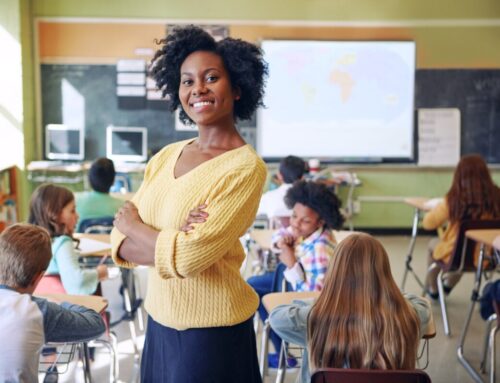
Education has changed a lot over the years. One of the biggest shifts is the move toward personalized instruction. This approach tailors learning to fit each student’s needs, strengths, and interests. Unlike traditional teaching, where everyone follows the same lesson plan, personalized instruction adjusts to help every student succeed. In this article, we’ll explore how personalized instruction works, why it’s effective, and how it compares to other methods like high-quality instruction and student-led instruction.
Start your journey to a brighter future—Enroll now!
What Is Personalized Instruction?
Personalized instruction is a teaching method that customizes learning based on each student’s:
-
Learning pace – Some students grasp concepts quickly, while others need more time. Personalized instruction lets them move at their own speed.
-
Interests – When lessons connect to what students care about, they stay engaged. For example, a math problem could involve sports stats for a student who loves basketball.
-
Strengths and weaknesses – Teachers identify where a student excels and where they need extra help, then adjust lessons accordingly.
This method ensures that no student gets left behind or feels bored because the work is too easy.
Why Personalized Instruction Works
Research shows that personalized instruction leads to better learning outcomes. Here’s why:
-
Students stay motivated – When lessons match their interests and abilities, students are more likely to put in effort.
-
Better understanding – Instead of memorizing facts, students truly grasp concepts because they learn in a way that makes sense to them.
-
Reduced frustration – Struggling students get the support they need, while advanced learners are challenged with deeper material.
Schools using personalized instruction often see higher test scores and more confident learners.
Personalized Instruction vs. High-Quality Instruction
While personalized instruction focuses on individual needs, high-quality instruction refers to well-planned, effective teaching for the whole class. Here’s how they compare:
-
High-quality instruction means using proven teaching strategies, clear explanations, and engaging activities for all students.
-
Personalized instruction takes it further by adjusting those strategies for each learner.
The best classrooms combine both. A teacher might start with high-quality instruction for the whole group, then use personalized instruction for small-group or one-on-one support.
How Student-Led Instruction Fits In
Another great teaching method is student-led instruction, where learners take charge of their own education. This might involve:
-
Choosing research topics
-
Setting learning goals
-
Working on projects they design
Student-led instruction works well with personalized instruction because both put the student’s needs first. When students have a say in their learning, they stay more engaged.
Ways to Implement Personalized Instruction
Teachers and parents can use personalized instruction in many ways:
-
Adaptive learning software – Programs like Khan Academy adjust difficulty based on student performance.
-
Flexible grouping – Teachers group students by skill level for certain subjects, then change groups as needed.
-
Choice boards – Students pick from different activities (e.g., writing an essay, making a video, or giving a presentation) to show what they’ve learned.
-
One-on-one conferences – Regular check-ins help teachers understand each student’s progress and struggles.
By using these strategies, educators make learning more effective and enjoyable.
Challenges of Personalized Instruction
While personalized instruction has many benefits, it also comes with challenges:
-
Time-consuming for teachers – Creating custom lessons takes more effort than using a standard curriculum.
-
Requires training – Not all teachers know how to personalize learning effectively.
-
Technology needs – Some tools, like adaptive software, require devices and internet access.
Despite these hurdles, many schools find the results worth the effort.
Success Stories: Schools Using Personalized Instruction
Many schools have seen great success with personalized instruction. For example:
-
A middle school in California let students pick projects based on their interests. Math scores improved by 20%.
-
An elementary school in Texas used adaptive reading apps. Struggling readers caught up to grade level in one year.
These examples show how powerful personalized learning can be.
Start your journey to a brighter future—Enroll now!
How Parents Can Support Personalized Learning
Parents play a big role in personalized instruction. Here’s how they can help:
-
Talk to teachers – Ask how lessons are tailored to your child’s needs.
-
Encourage interests – If your child loves science, provide books or experiments at home.
-
Use educational apps – Many apps adjust to your child’s learning level.
When parents and teachers work together, students get the best support.
The Future of Personalized Instruction
As technology improves, personalized instruction will become even more effective. Future trends include:
-
AI tutors – Artificial intelligence could give instant feedback and custom lesson plans.
-
Virtual reality learning – Students might explore history or science in immersive 3D worlds.
-
More student choice – Schools may offer even more ways for students to direct their learning.
These advancements will make education more engaging and effective for every student.
Final Thoughts
Personalized instruction is transforming education. By focusing on each student’s unique needs, it helps learners succeed in ways traditional methods can’t. Whether combined with high-quality instruction or student-led instruction, this approach makes learning more meaningful.
Schools, teachers, and parents all have a role to play in making personalized instruction work. With the right tools and strategies, every student can reach their full potential.
Would you like to see personalized instruction in your child’s school? Share your thoughts in the comments!
Start your journey to a brighter future—Enroll now!
FAQs
1. What is personalized instruction?
Personalized instruction is a teaching approach that tailors learning experiences to meet the individual needs, strengths, interests, and learning styles of each student.
2. How does personalized instruction differ from traditional teaching?
Traditional teaching often uses a one-size-fits-all method, while personalized instruction adapts the content, pace, and learning strategies to suit each student’s unique profile.
3. What are the benefits of personalized instruction?
Benefits include improved student engagement, higher motivation, better academic performance, and a deeper understanding of the material.
4. Is personalized instruction only for students who need extra help?
No. Personalized instruction benefits all learners, including advanced students, by challenging them at their level and pace.
5. How is personalized instruction implemented in the classroom?
Teachers may use tools like learning assessments, student choice in assignments, adaptive technology, small group work, and one-on-one instruction to personalize learning.
6. Can personalized instruction be used in online learning environments?
Yes. Many online platforms use data and AI to deliver adaptive content and feedback, making it easier to provide personalized learning paths.




